Marine Life & Conservation
Humankind… The Menace To Sharks
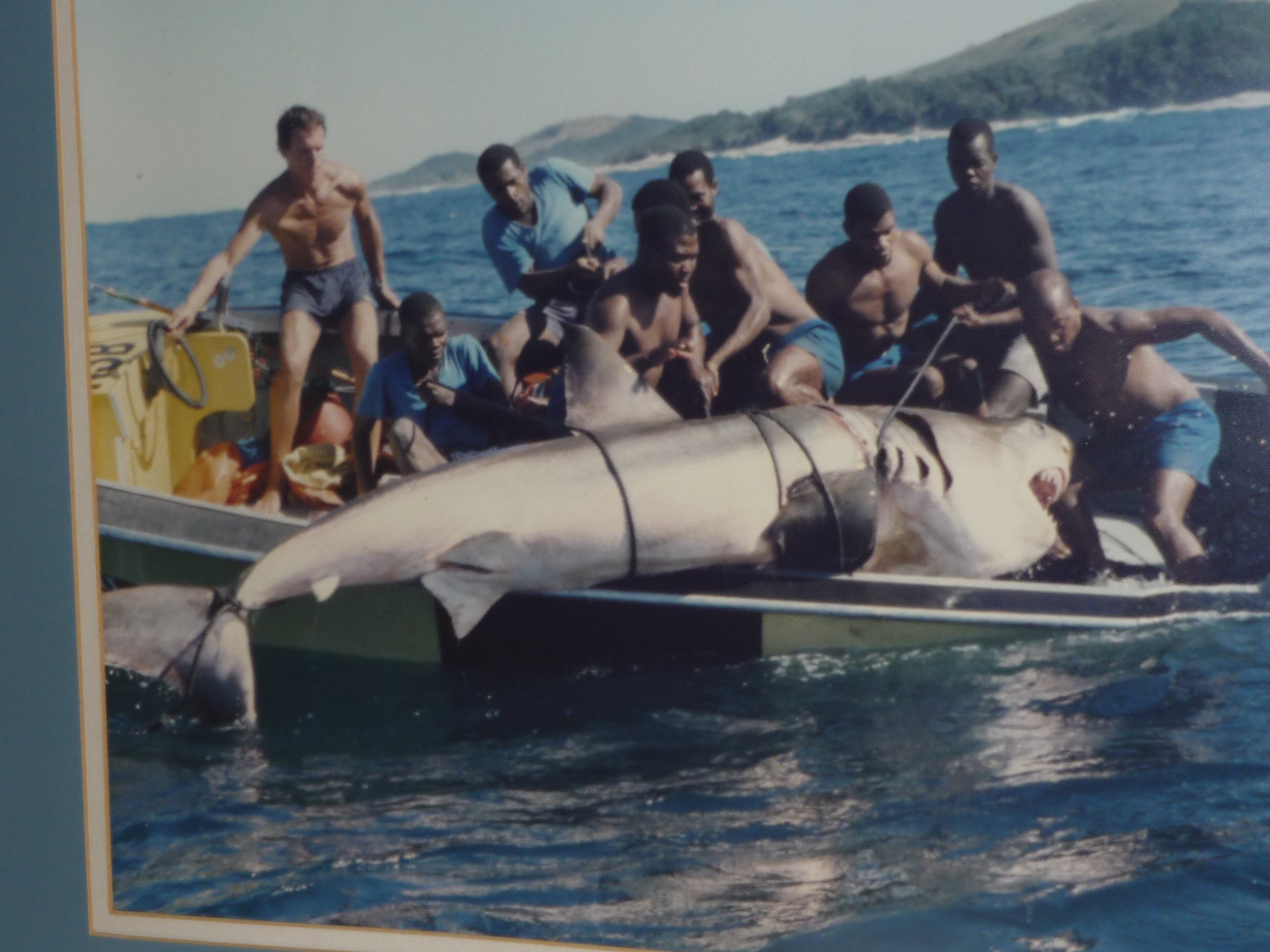
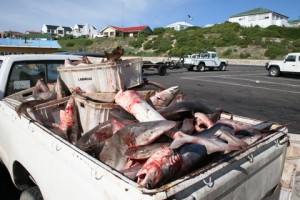 Results of pollution in the seas are not fully known, but what has been learned is that this practice not only endangers marine life, but human life as well. Algae that grow on reefs at the sea bottom collect toxins and small fish feed on these algae, ingesting these toxins with their meal. A tuna happens to feed on these smaller fish and in so doing, add the toxins from the algae plus all the toxins of every small fish it has eaten, into its system. A shark is the apex predator of the ocean and feeds on tuna, adding all the toxins from the algae from the reef plus every fish that has eaten it plus every small fish down the food chain, all carrying toxic waste into the shark! Sharks are killed by the thousands each day and the meat is consumed with the fins ending up as shark fin soup. This is then consumed by the greatest predator – the human being.
Results of pollution in the seas are not fully known, but what has been learned is that this practice not only endangers marine life, but human life as well. Algae that grow on reefs at the sea bottom collect toxins and small fish feed on these algae, ingesting these toxins with their meal. A tuna happens to feed on these smaller fish and in so doing, add the toxins from the algae plus all the toxins of every small fish it has eaten, into its system. A shark is the apex predator of the ocean and feeds on tuna, adding all the toxins from the algae from the reef plus every fish that has eaten it plus every small fish down the food chain, all carrying toxic waste into the shark! Sharks are killed by the thousands each day and the meat is consumed with the fins ending up as shark fin soup. This is then consumed by the greatest predator – the human being.
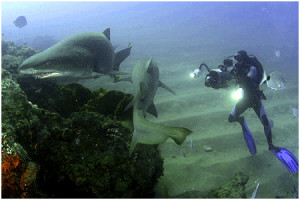 This process is recognised as Biomagnification; the toxins lodge in the fat and are not water soluble, neither can urination cleanse the system. The USDA has recommended that pregnant women, children and women of child-bearing age should not eat any shark-derived substance due to the excessive level of mercury therein. However, shark meat is eaten in many parts of the world but in certain countries it is viewed with distaste, possibly due to its proclivity to eat anything, as they are scavengers. Certainly the most widely found shark species eaten is the piked dogfish ( Squalus acanthias), which is tabled in Britain as “rock salmon” and in Australia as “flake.” Whatever it is called, this +/- one metre member of the shark family ends up on the menu. In closing this account of commercial use of shark products, the skin is turned into exceptional leather in use for belts, lady’s handbags and shoes. In reality, the skin, just like the leopard, looks better when the live animal is wearing it.
This process is recognised as Biomagnification; the toxins lodge in the fat and are not water soluble, neither can urination cleanse the system. The USDA has recommended that pregnant women, children and women of child-bearing age should not eat any shark-derived substance due to the excessive level of mercury therein. However, shark meat is eaten in many parts of the world but in certain countries it is viewed with distaste, possibly due to its proclivity to eat anything, as they are scavengers. Certainly the most widely found shark species eaten is the piked dogfish ( Squalus acanthias), which is tabled in Britain as “rock salmon” and in Australia as “flake.” Whatever it is called, this +/- one metre member of the shark family ends up on the menu. In closing this account of commercial use of shark products, the skin is turned into exceptional leather in use for belts, lady’s handbags and shoes. In reality, the skin, just like the leopard, looks better when the live animal is wearing it.
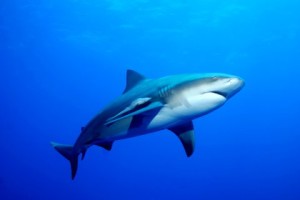 Sharks are the very essence of necessity in the ocean as they keep the waters clean and healthy, cleaning up dead or dying fish as well as sick specimens lower down the food chain. In fact, without them, there would be a proliferation of predators beneath them resulting in a paucity of specific prey items being available. This is due to the fact that large sharks are indeed slow breeders, very much slower than the predatory species below them. As an example, the dusky shark ( Carcharhinus obscurus) may take up to twenty two years to replace itself in the ocean. That is how long it takes to reach maturation and become available for breeding. Very little is known about the breeding cycle of the large sharks that are erroneously labelled “man- eaters.” The Great White, Tiger and the Bull sharks breeding biology has proved almost impossible to record. They do not breed in captivity, unlike large terrestrial or avian predators, where scientific evidence is available. Therefore, of the four hundred shark species in the oceans, comparatively very little is well or reliably documented in this respect.
Sharks are the very essence of necessity in the ocean as they keep the waters clean and healthy, cleaning up dead or dying fish as well as sick specimens lower down the food chain. In fact, without them, there would be a proliferation of predators beneath them resulting in a paucity of specific prey items being available. This is due to the fact that large sharks are indeed slow breeders, very much slower than the predatory species below them. As an example, the dusky shark ( Carcharhinus obscurus) may take up to twenty two years to replace itself in the ocean. That is how long it takes to reach maturation and become available for breeding. Very little is known about the breeding cycle of the large sharks that are erroneously labelled “man- eaters.” The Great White, Tiger and the Bull sharks breeding biology has proved almost impossible to record. They do not breed in captivity, unlike large terrestrial or avian predators, where scientific evidence is available. Therefore, of the four hundred shark species in the oceans, comparatively very little is well or reliably documented in this respect.
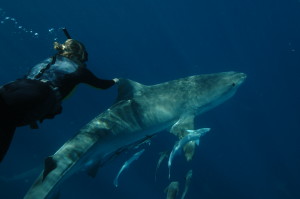 The three species above are well known to the reader as coming into conflict with recreational bathers and surfers alike. It is unfortunate that these incidents occur; the sea is there for our enjoyment, but then again it is also the domain of the shark. Scuba divers, more than anyone, know the attendant risks when entering the water, yet they accept that they are in the environment of the shark and behave accordingly. Today, many divers have experienced the thrill of encountering a Tiger or Great White and have taken a “ride” holding on to the animal. In most cases, the “passenger” has not worn scuba gear as the air bubbles emanating from the breathing apparatus may cause the animal certain disquietude. A female friend of mine has done “ballet” with an Oceanic White Tip shark. It is by no means recommended that EVEYONE try this but these are facts and if the conditions are favourable and the person respectful and qualified, no greater “rush” is possible! Swimming with an ocean apex predator!
The three species above are well known to the reader as coming into conflict with recreational bathers and surfers alike. It is unfortunate that these incidents occur; the sea is there for our enjoyment, but then again it is also the domain of the shark. Scuba divers, more than anyone, know the attendant risks when entering the water, yet they accept that they are in the environment of the shark and behave accordingly. Today, many divers have experienced the thrill of encountering a Tiger or Great White and have taken a “ride” holding on to the animal. In most cases, the “passenger” has not worn scuba gear as the air bubbles emanating from the breathing apparatus may cause the animal certain disquietude. A female friend of mine has done “ballet” with an Oceanic White Tip shark. It is by no means recommended that EVEYONE try this but these are facts and if the conditions are favourable and the person respectful and qualified, no greater “rush” is possible! Swimming with an ocean apex predator!
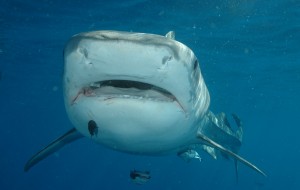 Apart from by-catch and gill nets, shark finning, over-fishing, coral destruction and pollution are top of the list with regard to decimation of marine life. Deep sea trawling has proved to be the number one culprit in killing large species of shark and these are hauled aboard, their fins cut off and the squirming animal tossed back into the sea to suffocate. Notwithstanding this awful slaughter, many other harmless forms of marine life are also victims of this “method.” Dolphins, rays, turtles and coral are to name a few. The very ecosystem is damaged every time sea bottom trawling is commenced. Apparently no legislation is in place to prevent bottom trawling but the consequences will be felt in the not too distant future.
Apart from by-catch and gill nets, shark finning, over-fishing, coral destruction and pollution are top of the list with regard to decimation of marine life. Deep sea trawling has proved to be the number one culprit in killing large species of shark and these are hauled aboard, their fins cut off and the squirming animal tossed back into the sea to suffocate. Notwithstanding this awful slaughter, many other harmless forms of marine life are also victims of this “method.” Dolphins, rays, turtles and coral are to name a few. The very ecosystem is damaged every time sea bottom trawling is commenced. Apparently no legislation is in place to prevent bottom trawling but the consequences will be felt in the not too distant future.
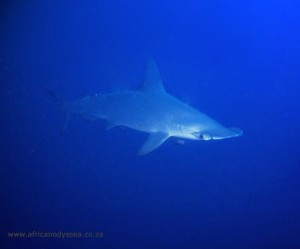 I was once asked, “Why do you suppose that nets are used along the popular beaches?” My answer to that was “To protect the recreational bathers from a potentially harmful encounter with a shark?” The answer to my reply stunned me. “No, to cull sharks!” This form of affording protection is outdated and other methods may be employed to achieve the same results. The current gill nets being used in South African and Australian waters have a mesh size large enough to allow the head of a biggish shark to enter and then ensnare the animal around the gill slits. No shark can swim backwards, so without being able to flow water through the gills, drowning ensues. Thousands of forms of sea life are killed annually by gill netting, in spite of the fact that fewer and fewer sharks are netted. But the nets remain.
I was once asked, “Why do you suppose that nets are used along the popular beaches?” My answer to that was “To protect the recreational bathers from a potentially harmful encounter with a shark?” The answer to my reply stunned me. “No, to cull sharks!” This form of affording protection is outdated and other methods may be employed to achieve the same results. The current gill nets being used in South African and Australian waters have a mesh size large enough to allow the head of a biggish shark to enter and then ensnare the animal around the gill slits. No shark can swim backwards, so without being able to flow water through the gills, drowning ensues. Thousands of forms of sea life are killed annually by gill netting, in spite of the fact that fewer and fewer sharks are netted. But the nets remain.
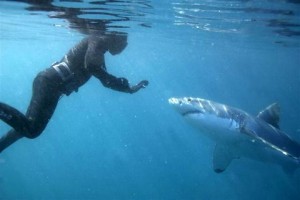 The Red List of the IUCN (The World Conservation Union) 2008 contains the names of endangered animals and plants and unfortunately includes many shark species. Of the nearly 400 species of shark, 100 species appear on the list and are being commercially exploited daily. The following list of well-known species is an indication of the seriousness and sustainability of these animals in the future:
The Red List of the IUCN (The World Conservation Union) 2008 contains the names of endangered animals and plants and unfortunately includes many shark species. Of the nearly 400 species of shark, 100 species appear on the list and are being commercially exploited daily. The following list of well-known species is an indication of the seriousness and sustainability of these animals in the future:
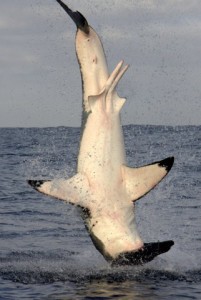 Great White Shark…..VU (threatened and vulnerable)
Great White Shark…..VU (threatened and vulnerable)
Great hammerhead….DD (data deficient)
Hammerhead sp……..LR/nt (in a threatened category in the near future)
Tiger Shark…………….LR/nt ( “ “ “)
Bull Shark………………LR/nt (“ “ “)
Raggedtooth Shark…VU (threatened and vulnerable)
As more data comes to light, the present picture will not show any improvement.
 Human Beings have a fear of predators from early childhood and this fear is exacerbated into adulthood. The word “shark” conjures up an image of being eaten alive or horrific injuries being inflicted. No thought is given to the horrors Human Beings inflict on each other but that invisible “thing” lurking in the sea is beyond words and must be done away with. Sharks are not wanton killers waiting for a person to enter the sea in order to get a meal! If this was the case, over-population of the human race would be reduced. Extinction is irreversible and, for us, to be responsible for having ONE species of animal go that way is unforgivable. Sharks have inhabited the oceans for millennia, because… that is where they are meant to be.
Human Beings have a fear of predators from early childhood and this fear is exacerbated into adulthood. The word “shark” conjures up an image of being eaten alive or horrific injuries being inflicted. No thought is given to the horrors Human Beings inflict on each other but that invisible “thing” lurking in the sea is beyond words and must be done away with. Sharks are not wanton killers waiting for a person to enter the sea in order to get a meal! If this was the case, over-population of the human race would be reduced. Extinction is irreversible and, for us, to be responsible for having ONE species of animal go that way is unforgivable. Sharks have inhabited the oceans for millennia, because… that is where they are meant to be.
Main Photo by Trevor Krull
Marine Life & Conservation
Shark Trust launches Oceanic 31 Shark Art Auction

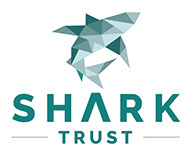 After a two-year tour of UK art galleries, community spaces and aquariums, the Shark Trust’s acclaimed Oceanic31 exhibition takes its final bow at the Royal Geographical Society later this month. And the unique collection of artwork, depicting 31 species of oceanic sharks and rays, donated by 31 artists, is now open for bids from art lovers and shark enthusiasts. The online auction, launched today, will close on the 7th December at 8pm (BST). The money raised will support the Shark Trust Oceanics Programme.
After a two-year tour of UK art galleries, community spaces and aquariums, the Shark Trust’s acclaimed Oceanic31 exhibition takes its final bow at the Royal Geographical Society later this month. And the unique collection of artwork, depicting 31 species of oceanic sharks and rays, donated by 31 artists, is now open for bids from art lovers and shark enthusiasts. The online auction, launched today, will close on the 7th December at 8pm (BST). The money raised will support the Shark Trust Oceanics Programme.
People can now bid on 27 of the artworks by visiting this website:
https://superstars-auctions.com/sharktrustauction
It is a chance to own a beautiful piece of original art and to support the Shark Trust. The timing of the auction also means that these would make a very special Christmas gift for any shark-lover.
- Bigeye Thresher Shark by Janina Rossiter
- Carcharodon carcharias by Jimmy Higgs
- Croc VR 2030 by Tom Mead
- Oceanic Whitetip by ATM
- Silky Street by ScapaJoe
The diversity of pieces mirrors that of the sharks and rays they represent. You can bid on paintings, digital creations, sculptures, mixed media and more. You can pick your favourite artist or species of shark. Or you can select the perfect artwork to make a statement in your home or office. Whichever you choose, you will be supporting the work to protect these amazing animals.
One of the pieces of art has been selected to be auctioned live by Steve Backshall at the For the Love of Sharks event at the Royal Geographical Society in London on the 29th November. In addition to this, two further pieces will be raffled at this event, giving people a chance to win an incredible piece of shark art. For the Love of Sharks is the Shark Trust’s flagship evening. A night to celebrate sharks. Steve Backshall is the headline speaker at this event that will see other prominent shark advocates join him on stage.
Tickets for the event can be snapped up here:
https://thesharktrust.org.uk/Event/flos24
Those that would like to see the Oceanic 31 exhibition have one final chance. It is being displayed at the Pavilion at the Royal Geographic Society from 26th November until the 7th December. Entry is free.
Find out more here:
https://www.rgs.org/events/upcoming-events/oceanic-31
Paul Cox, Shark Trust CEO, Said “This exhibition has given us the opportunity to reach out to a new audience. And inspire more people with the wonderful sharks and rays on which our Big Shark Pledge campaign is based. We are immensely grateful to the 31 artists who have worked so hard to create these works.”
Bid for your favourite Oceanic 31 artwork here:
https://superstars-auctions.com/sharktrustauction
Banner Image: Smooth Hammerhead by Alicia Hayden
Marine Life & Conservation
Meet Steve Backshall in the Bite-Back Prize Draw

Until 28 November, prizes worth a massive £10,000 – including experiences, products and tuition – feature in a line-up of items that can be won for £5 in an online prize draw to celebrate Bite-Back Shark & Marine Conservation’s 20th anniversary and help generate crucial funds for the future.
Top of the list of prizes is the chance to spend time with adventurer and wildlife expert Steve Backshall, a workout session with Nat Geo star Aldo Kane, a kayaking trip alongside white-water expert and diver Sal Montgomery and a Zoom call with ‘shark whisperer’ Cristina Zenato.
On top of that, some of the most admired companies in the diving and scuba industry have been quick to support the charity with fabulous prizes that make the £5 ticket price worth more than just a flutter.
Master Liveaboards, BSAC, Midlands Diving Chamber, Go Freediving and Blue Shark Snorkel have all generously donated experience prizes, while celebrated photographer Alex Mustard has donated a print and artists Scott Gleed and Olivier Leger have donated a sculpture and illustration to help boost the fundraising pot.
Fourth Element has donated Ocean Positive gear and LA watch company Nodus has gifted the charity a stunning dive watch. For land lovers, the charity has included a five star London hotel stay at Bankside Hotel plus a family visit to Longleat Safari Park in the roster of prizes.
Campaign director for Bite-Back, Graham Buckingham, said: “We’ve been overwhelmed with support from companies and individuals that we truly admire and who have supported us on our 20 year journey and we’re truly grateful to them all. While we feel incredibly proud of our achievements over the past two decades – and we are super excited about the next chapter – this prize draw isn’t a vanity project. It represents a real lifeline to our work and important advancements in the global protection of sharks. So we hope divers, dive clubs and even bargain hunters grab some tickets to make this a massive success.”
The charity hopes that the prize draw will generate crucial funds to launch a brand new, ground-breaking, campaign to enrol the public and increase support for the protection of sharks around the world.
To enter the competition visit www.bite-back.com/prizedraw. The prize winners will be announced on 1 December 2024.
-

 News1 month ago
News1 month agoIconic SS United States to become the World’s Largest Artificial Reef
-

 Blogs3 months ago
Blogs3 months agoNovoScuba’s Game-Changing Approach for Dive Store Owners: WE PAY YOU!
-

 News2 months ago
News2 months agoBook Review – 52 Assignments: Underwater Photography
-

 Gear News2 months ago
Gear News2 months agoDYNAMICNORD – New German diving brand enters the British market
-

 News2 months ago
News2 months agoExploring Cenote El Pit: A Diver’s Dream
-

 Gear News2 months ago
Gear News2 months agoTry BARE drysuits (and maybe even win one!) this Friday with Sea & Sea at North West Dive Fest
-

 News3 months ago
News3 months agoComing Soon – 52 Assignments
-

 News3 months ago
News3 months agoSave £200 per person per week at Pole Pole Lodge with Dive Worldwide








